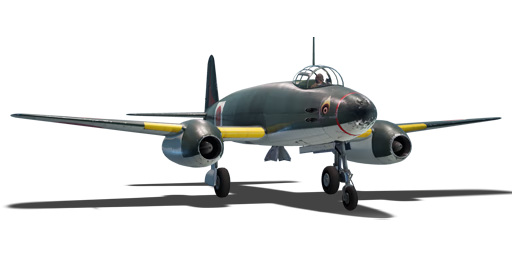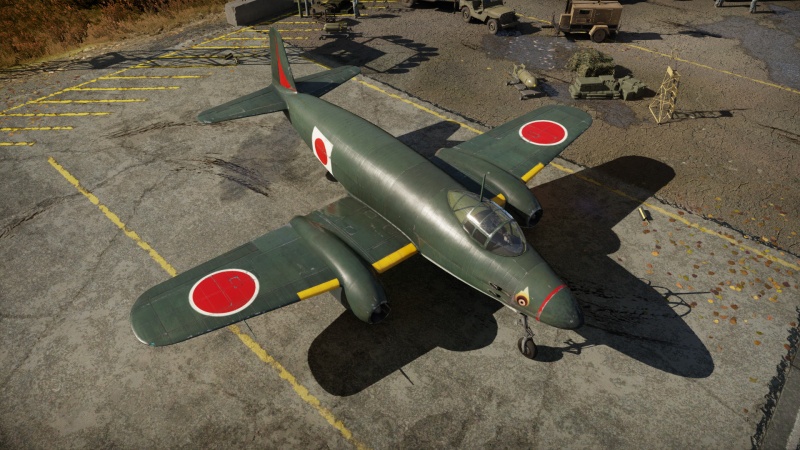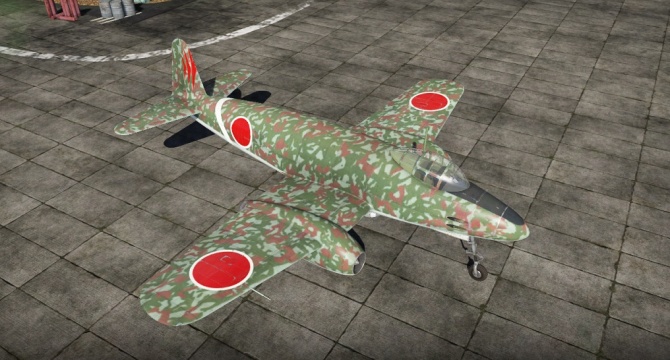R2Y2 Kai V1
| This page is about the Japanese jet fighter R2Y2 Kai V1. For other versions, see R2Y (Family). |
Contents
Description
The R2Y2 Keiun-Kai V1 is a rank V Japanese jet fighter with a battle rating of 7.3 (AB), 8.0 (RB), and 7.0 (SB). It was introduced in Update 1.43.
Even though the R2Y2 is able to equip an 800 kg bomb, it wields a powerful set of 4 x 30 mm Type 5 cannons, mounted in the nose. This aircraft trio is similar to the Me 262 series as they all lack an engine or propeller in the front of the plane. Thus, the R2Y2 and its German counterpart can wield an impressive set of cannons. The R2Y2 series wields four Type 5 cannons with a large ammunition pool. Although the rates of fire of these and the Mk 108's on the Me262 are comparable, this fact of a higher ammunition count allows the R2Y2 to be able to destroy more aircraft without having to return to base. In arcade battles, having a large ammunition pool is also useful as it will often be unnecessary to reload. 4 x 30 mm Type 5 cannons with a ammo load of 600 rounds (150 rounds per gun) means the R2Y2 is effective at almost any role you chose to play it as. As an attacker or an interceptor, the R2Y2 is an effective multi-role aircraft for the Japanese at era V.
General info
Flight performance
| Characteristics | Max Speed (km/h at 3,500 m) |
Max altitude (metres) |
Turn time (seconds) |
Rate of climb (metres/second) |
Take-off run (metres) | |||
|---|---|---|---|---|---|---|---|---|
| AB | RB | AB | RB | AB | RB | |||
| Stock | 820 | 797 | 12500 | 31.0 | 31.5 | 16.2 | 15.0 | 750 |
| Upgraded | 883 | 851 | 29.3 | 30.0 | 24.2 | 20.0 | ||
Details
| Features | |||||
|---|---|---|---|---|---|
| Combat flaps | Take-off flaps | Landing flaps | Air brakes | Arrestor gear | Drogue chute |
| ✓ | ✓ | ✓ | X | X | X |
| Limits | ||||||
|---|---|---|---|---|---|---|
| Wings (km/h) | Gear (km/h) | Flaps (km/h) | Max Static G | |||
| Combat | Take-off | Landing | + | - | ||
| 960 | 350 | 498 | 469 | 320 | ~10 | ~4 |
| Optimal velocities (km/h) | |||
|---|---|---|---|
| Ailerons | Rudder | Elevators | Radiator |
| < 650 | < 600 | < 680 | N/A |
Engine performance
| Engine | Aircraft mass | ||||||
|---|---|---|---|---|---|---|---|
| Engine name | Number | Empty mass | Wing loading (full fuel) | ||||
| Mitsubishi Ne-330 | 2 | 5,400 kg | 243 kg/m2 | ||||
| Engine characteristics | Mass with fuel (no weapons load) | Max Takeoff Weight | |||||
| Weight (each) | Type | 13m fuel | 20m fuel | 30m fuel | 44m fuel | ||
| 1,200 kg | Axial-flow turbojet | 6,142 kg | 6,513 kg | 7,043 kg | 7,784 kg | 9,950 kg | |
| Maximum engine thrust @ 0 m (RB / SB) | Thrust to weight ratio @ 0 m (100%) | ||||||
| Condition | 100% | WEP | 13m fuel | 20m fuel | 30m fuel | 44m fuel | MTOW |
| Stationary | 1,300 kgf | N/A | 0.42 | 0.40 | 0.37 | 0.33 | 0.26 |
| Optimal | 1,300 kgf (0 km/h) |
N/A | 0.42 | 0.40 | 0.37 | 0.33 | 0.26 |
Survivability and armour
Examine the survivability of the aircraft. Note how vulnerable the structure is and how secure the pilot is, whether the fuel tanks are armoured, etc. Describe the armour, if there is any, and also mention the vulnerability of other critical aircraft systems.
Modifications and economy
- The R2Y2's biggest downfall is its speed.
- Start by unlocking the performance modules first, as they will increase survivability more so than any armament upgrades.
- Being able to use the "Stealth" belt for the 30 mm cannons is a huge advantage over Tracer and Universal, provided you can aim, as the Tracer shells halve the HE fillers.
Armaments
Offensive armament
The R2Y2 Kai V1 is armed with:
- 4 x 30 mm Type 5 cannons, nose-mounted (150 rpg = 600 total)
Suspended armament
The R2Y2 Kai V1 can be outfitted with the following ordnance:
- Without load
- 1 x 800 kg Navy Type Number 80 Model 1 bomb (800 kg total)
- 1 x 800 kg Navy Type 99 Number 80 AP bomb (800 kg total)
Usage in battles
The R2Y2 is best utilized as a medium-altitude fighter in all game modes. Due to its lacklustre acceleration, like many jets, gaining airspeed as early as possible is crucial. Once the R2Y2 pilot loses his or her speed, they are easy prey for faster-accelerating propeller aircraft. It is important to always have a high speed when attacking enemies as otherwise they will often be able to slot in on your tail in a matter of seconds. This short time can be a matter of life or death as many fast-turning propeller aircraft such as the Spitfire wield impressive armaments with high burst masses. However, these advantages can be nullified once the R2Y2 pilot has the ability to dive away at high speeds.
If followed by a jet fighter or heavier propeller-driven plane, evading enemies with the R2Y2 is often easy. Though its maximum speed is lower than that of, say, the F-80A-5, it is faster than certain early jets like the Meteor F Mk 3, is a great climber, and has a low stall speed. It can turn better than many jets it faces as well. Needless to say, if an enemy is on the jet's six, the R2Y2 pilot can always call for teammate assistance. Not only can one keep the enemy greedy and focused on his or her tail, but this pilot can also "set up" that enemy for a teammate to destroy. If found alone, it can be possible to catch propeller planes in a "speed trap" where once you start to outrun the enemy you pitch up to gain altitude. Once the enemy propeller stalls out, dive on them. If the first pass doesn't result in a massive fuel fire and explosion, set up the same approach as before. Even if the propeller plane has the ability to outmanoeuvre the R2Y2, it is still very daunting to have to dodge an aircraft armed with four 30 mm cannons.
The R2Y2 can also be beneficial to any battles as a ground attacker. Its 30 mm Type 5 cannons have the ability to equip armour-piercing rounds which are capable of destroying light tanks, medium tanks, and light pillboxes, among other targets. This, coupled with the single 800 kg bomb, can cause some serious damage to the opposing team.
Pros and cons
Pros:
- 4 x 30 mm Type 5 cannons mounted in the nose with a very generous ammo count of 600 rounds
- Very manoeuvrable for an early jet
- Clear cockpit with good all-round vision (excellent for SB pilots in particular)
- Engines mounted below the centre of gravity, allowing advance low-speed manoeuvres such as a double back-flip (without instructor)
Cons:
- Poor acceleration (although is decent at low speed)
- No armour protection whatsoever on the aircraft
- V1 version has wing-mounted jet engines that can be easy targets to hit
- Limited bomb selection if used as an Attacker/Jet Bomber
- Easy target
- Sometimes difficult to line up guns
- Poor rate of roll
History
The R2Y2 was a jet-powered version of the R2Y1 designed by Kugisho. Known as the Keiun or Keiun-Kai ("Beautiful Cloud" in Japanese) the aircraft would be a high-speed jet-bomber/attacker that could be used in the defence of the home islands of the Japanese empire. The power plant of the jet Keiun-Kai would be a pair of Mitsubishi Ne-330 turbojet engines mounted in pods located, with one under each wing. Later versions (V2 and V3) would feature the engines mounted centrally within the fuselage.
The Y-40 project began with failure of the Kugisho R1Y1 (Y-30) project for a fast, high-speed reconnaissance aircraft. The development of that project, along with inspiration from the German Heinkel He 119, the R2Y (Y-40) project was developed. Initially intended as a fast reconnaissance aircraft with a long-range that could be operated from land bases across the Japanese Empire, that would avoid interception with high-speed flight, however, Kugisho also informed the IJN that the aircraft could be adapted to other roles. They proposed that the planned Aichi Ha-70 engine powerplant of the R2Y1 could be replaced by a pair of Mitsubishi Ne-330 turbojet engines. Nonetheless, work on the R2Y1 continued, however, it proved troublesome due to the Aichi powerplant. Issues with the R2Y1 airframe, its powerplant and interference from American bombing prevented the development of the project past the piston-engine variant. By April 1945 the first prototype of the Keiun was ready for initial trials, with the first flight in early May of the same year. The R2Y1 suffered engine-cooling issues during its early development, and fire occurred during ground-testing that would damage the aircraft and its powerplant.
This would not be the only disaster of the project, as the first prototype was completely destroyed by a bombing raid, further damaging the R2Y's chances of ever becoming an operational aircraft. The second R2Y1 prototype was still under construction at the time of the Japanese surrender on August 15th and the R2Y2 remained on the drawing board.
V1 Variant
The V1 variant of the R2Y2 featured a somewhat conventional design for an early jet aircraft in that it featured two engines (due to the low thrust and power of early jets) mounted in pods, with one under each wing. A similar configuration to that featured on the Me 262 Schwalbe, Gloster Meteor and Nakajima Kikka jet aircraft. All 3 variants feature a pair of Mitsubishi Ne-330 turbojet engines. The V1 is the R2Y2 in its most basic configuration that was very much the rushed conversion from the R2Y1. Due to the limited time frame on the project and the severity of the situation facing Japan in 1945, the V1 was chosen out of the 3 proposed R2Y2 variants, due to the lower cost to produce it.
For further development, see the R2Y2 V2 and V3.
Media
- Skins
- Images
See also
Other aircraft of the same series
Other aircraft of similar design and capabilities
External links
| Yokosuka Naval Air Technical Arsenal (海軍航空技術廠) | |
|---|---|
| Bombers | D4Y1 · D4Y2 · D4Y3 Ko |
| P1Y1 mod. 11 | |
| Jet fighters | R2Y2 Kai V1 · R2Y2 Kai V2 · R2Y2 Kai V3 |
| Captured | ␗P1Y1 mod. 11 |
| While the arsenal was simply known as the Naval Air Technical Arsenal and usually referred to as Kūgi-shō (Kaigun Kōkū Gijutsu-shō). | |
| The name Yokosuka prevailed however, even though it referred to the Arsenal's location. | |
| See also | Yokosuka Naval Arsenal (Shipyard) |
| Japan jet aircraft | |
|---|---|
| IJNAS | |
| Experimental | Kikka |
| Reconnaissance | R2Y2 Kai V1 · R2Y2 Kai V2 · R2Y2 Kai V3 |
| IJAAS | |
| Fighters | Ki-200 |
| JASDF | |
| Fighters | F-86F-30 ▅ · F-86F-40 ▅ · F-86F-40 JASDF▅ |
| F-104J | |
| F-4EJ Phantom II · F-4EJ ADTW · F-4EJ Kai Phantom II | |
| F-15J · F-15J(M) | |
| F-16AJ | |
| F-1 | |
| Trainers | T-2 Early · T-2 |
| Foreign | |
| Thailand | ▄AV-8S · ▄F-5E FCU |








